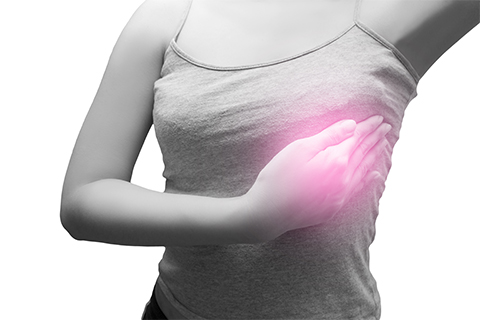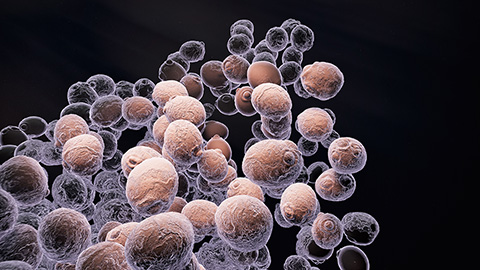From the journals: JLR
Switching cancer cells from pro- to antitumor. Species-specific skeletal muscle metabolism. Protein deletion improves metabolic disorders Read about papers on these topics recently published in the Journal of Lipid Research.
Switching cancer cells from pro- to antitumor

Breast cancer is the second most common malignant cancer in women, according to the National Cancer Institute. Enzymatically driven cholesterol oxidation by CYP27A1 produces two classes of products with tumor-promoting properties: oxysterols, such as oncosterone, or OCDO, and 27-hydroxy-cholesterol, or 27-HC. OCDO and 27-HC promote tumor progression of estrogen receptor–positive, or ER+, breast cancer; whereas only OCDO drives triple-negative breast cancers. Researchers do not yet know if CYP27A1, which produces 27-HC from cholesterol, can also modify OCDO in humans, which could be harnessed to promote an antitumor cellular program.
In a recently published study in the Journal of Lipid Research, Silia Ayadi and a team from the Cancer Research Center of Toulouse, France, and the University Hospital Bonn, Germany, investigated whether OCDO can be terminally hydroxylated. The researchers first chemically synthesized possible OCDO derivatives. Using these products as chemical standards, they performed metabolomics on lipid extracts from human breast cancer cell lines, with varying expression levels of CYP27A1. They identified the formation of 27-hydroxylated (27H) products of 5;6-EC (5,6-epoxycholestan-3βol), CT (cholestane-3β,5α,6βtriol) and OCDO (6-oxocholestane-3β, 5α-diol) in the cancer cell lines that overexpress CYP27A1 but not in controls without CYP27A1. The researchers found that 27H-OCDO has antiproliferative properties and inhibits the breast cancer cell proliferation, driven by OCDO and 27-HC.
The authors concluded that the hydroxylated metabolites they identified might be able to switch CYP27A1 from pro- to antitumor activity. In addition, these endogenous metabolites could be investigated as future cancer therapeutics.
Species-specific skeletal muscle metabolism
Skeletal muscle function supports daily activities and maintains whole-body metabolic equilibrium. High-density lipoprotein, or HDL, accepts excess cholesterol from blood and carries to the liver for disposal, increasing glucose uptake and fatty acid oxidation in primary human myotubes, a building block of skeletal muscle, derived from patients with Type 2 diabetes. However, the effects of different HDL subtypes on muscle cells from patients with Type 2 diabetes are unknown.
A recently published study in the Journal of Lipid Research by Jenny Lund and Emilia Lähteenmäki and a group of researchers from Norway and Finland explored the effect of human HDL subclasses, HDL2 and HDL3, on glucose and fatty acid metabolism in mouse and primary human skeletal muscle myotubes and found distinct metabolic profiles for the two species. They observed elevated levels of fatty acid uptake and oxidation as well as a decrease in glucose uptake and oxidation in human myotubes upon HDL2 and HDL3 treatments. Conversely, this treatment enhanced glucose metabolism through glycolytic pathways in mouse myotubes at lower glucose concentrations or fasted state, suggesting HDL may drive anaerobic pathways that lead to glucose disposal. The researchers also found upregulated expression of fatty acid metabolism genes, such as angiopoietin like 4, peroxisome proliferator-activated receptor gamma coactivator 1 alpha, hexokinase 2 and pyruvate dehydrogenase kinase genes upon HDL2 and HDL3 treatment of human myotubes.
Future research will focus on examining the protein and lipid composition of HDL subclasses and how these affect cellular metabolism and the dysregulation of glucose and lipid metabolism in Type 2 diabetes.
Protein deletion improves metabolic disorders
The collection of trillions of microorganisms, such as bacteria, archaea and eukaryotes, colonizing the gastrointestinal tract are known as the gut microbiome, which plays an important role in human metabolism process. Altered gut bacterial composition, or dysbiosis, can lead to metabolic disorders, such as gastrointestinal diseases, cancer and others. Small heterodimer partner, or Shp, is an atypical orphan nuclear receptor that regulates several processes in the liver, including bile acid, lipid and glucose homeostasis as well as immune responses. The synergistic effects of dysregulated bile acids and gut microbiota contribute to various metabolic disorders, such as obesity and nonalcoholic steatohepatitis, or NASH. Therefore, researchers investigated how Shp contributes to microbial dysbiosis during obesity and NASH.
In a recent Journal of Lipid Research study, Ryan Mifflin, Jung Eun Park and Mikang Lee from Northeast Ohio Medical University and a group of researchers from across the United States showed that Shp deletion improves symptoms in mouse models of obesity and NASH. They studied the metabolic and gut microbial profiles of wild-type and Shp knockout mice using cohousing experiments. Shp knockout mice reared separately from wild-type mice showed decreased triglycerides and elevated levels of deoxycholic acid, a secondary bile acid. Using 16S ribosomal RNA sequencing, researchers showed that Shp knockout mice contained elevated levels of Bacteroidales and Clostridiales bacteria compared to wild-type mice. Cohousing of Shp knockout and wild-type mice disrupted this enrichment and returned levels to baseline. The authors showed that, on a Western diet, Shp knockout mice had decreased fat absorption as well as microbial-derived serum lipopolysaccharide and phenylacetic acid levels compared to controls.
These data suggest that Shp ablation may modulate the microbiome to improve obesity and NASH outcomes and may provide a viable therapeutic strategy for obesity and NASH patients. Future directions will explore the functional pathways of the microbial communities that mediate the changes seen in Shp knockout mice in models of obesity and NASH.
Enjoy reading ASBMB Today?
Become a member to receive the print edition four times a year and the digital edition monthly.
Learn moreGet the latest from ASBMB Today
Enter your email address, and we’ll send you a weekly email with recent articles, interviews and more.
Latest in Science
Science highlights or most popular articles

Designing life’s building blocks with AI
Tanja Kortemme, a professor at the University of California, San Francisco, will discuss her research using computational biology to engineer proteins at the 2026 ASBMB Annual Meeting.

Cholesterol as a novel biomarker for Fragile X syndrome
Researchers in Quebec identified lower levels of a brain cholesterol metabolite, 24-hydroxycholesterol, in patients with fragile X syndrome, a finding that could provide a simple blood-based biomarker for understanding and managing the condition.

How lipid metabolism shapes sperm development
Researchers at Hokkaido University identify the enzyme behind a key lipid in sperm development. The findings reveal how seminolipids shape sperm formation and may inform future diagnostics and treatments for male infertility.

Mass spec method captures proteins in native membranes
Yale scientists developed a mass spec protocol that keeps proteins in their native environment, detects intact protein complexes and tracks drug binding, offering a clearer view of membrane biology.

Laser-assisted cryoEM method preserves protein structure
University of Wisconsin–Madison researchers devised a method that prevents protein compaction during cryoEM prep, restoring natural structure for mass spec studies. The approach could expand high-resolution imaging to more complex protein systems.

Method sharpens proteome-wide view of structural changes
Researchers developed a method that improves limited proteolysis coupled with mass spectrometry, separating true changes from abundance or splicing effects.

